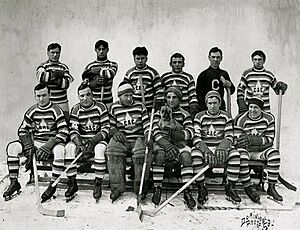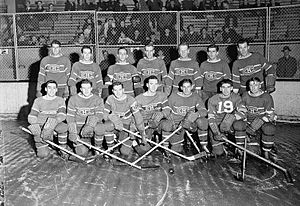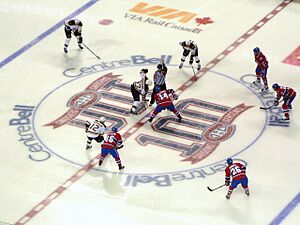History of the Montreal Canadiens facts for kids
The Montreal Canadiens, also known as Le Club de Hockey Canadien, is a famous ice hockey team. It was started on December 4, 1909. The Canadiens are the oldest professional hockey team in the world! They were created to be a team for French-speaking people in Montreal. Their first game was on January 5, 1910. They won their first Stanley Cup in 1916. The team helped create the National Hockey League (NHL) in 1917. They have won the Stanley Cup 24 times, making them the most successful team in NHL history.
The Canadiens' first home rink, the Montreal Arena, burned down in 1918. They moved to the Jubilee Arena, which also burned down in 1919. After playing in the Mount Royal Arena for seven seasons, they moved to the Montreal Forum in 1926. They shared it with the Montreal Maroons until 1938. After 72 years at the Forum, they moved to the Bell Centre in 1996. The team had some tough times during the Great Depression. They almost moved to Cleveland in 1935. But their luck changed after World War II. They played in the Stanley Cup Finals every year from 1951 to 1960. They won six championships, including a record five in a row from 1956 to 1960!
Maurice "Rocket" Richard became the team's big star in the 1940s. In the 1944–45 season, he was the first player in NHL history to score 50 goals in one season. Richard's suspension in 1955, after an incident with a linesman, caused a big protest known as the Richard Riot. This event showed the growing tensions between French Quebec and English Canada. In 1959, Jacques Plante changed the game forever. He became the first goalie to always wear a mask during games. Under general manager Sam Pollock, the Canadiens won nine championships between 1964 and 1978. The 1976–77 team is often called the greatest in NHL history. They won 60 games and lost only 8, which was a record for fewest losses. When the Quebec Nordiques joined the NHL in 1979, a big rivalry started between the Canadiens and the Nordiques. This rivalry was very intense in 1984, with some very memorable games.
Led by goalie Patrick Roy, the Canadiens won their 23rd Stanley Cup in 1986. They won their 24th in 1993. Roy won the Conn Smythe Trophy as the playoffs' most valuable player both times. The 1993 team set an NHL record with 10 overtime wins in one playoff year. This was the last time a Canadian team won the Stanley Cup. In 2003, Montreal played in the first regular season outdoor game in NHL history, called the Heritage Classic. They beat the Edmonton Oilers. More than 50 former Canadiens players and ten team leaders have been inducted into the Hockey Hall of Fame. The team has retired 15 numbers, honoring 17 players.
Contents
- How the Canadiens Started
- Playing in the National Hockey Association (1910–1917)
- Early National Hockey League Years (1917–1932)
- Howie Morenz and Rocket Richard (1932–1946)
- The Original Six Era (1946–1967)
- The Expansion Era (1967–1979)
- Changes and New Success (1980–1996)
- New Home and New Owners (1996–2009)
- Molson Family Buys Team Again (2009–Present)
- Retired Numbers
- Hockey Hall of Famers
- See also
How the Canadiens Started
In November 1909, a businessman named Ambrose O'Brien was in Montreal. He was there for hockey meetings. His team, the Renfrew Creamery Kings, wanted to join a league called the ECHA. But the ECHA owners said no. Later that day, the ECHA owners decided to form a new league, the Canadian Hockey Association (CHA). They wanted to leave out the Montreal Wanderers team.
O'Brien then met Jimmy Gardner, the Wanderers' manager. They talked about starting a new league. Gardner suggested O'Brien create a team of French-speaking players in Montreal. This would create a rivalry with the Wanderers. So, the National Hockey Association (NHA) was formed on December 2, 1909. The Canadiens team was created two days later. O'Brien first paid for the team. He wanted to give ownership to French-speaking sports fans in Montreal as soon as possible.
At that time, many thought French-speaking teams were not good enough to play with the top English-speaking teams. The Montreal Gazette newspaper even warned fans not to get too excited. They said "French-Canadian players of class are not numerous." But the Canadiens filled their team with French-speaking stars. These included Newsy Lalonde, Georges Poulin, and Didier Pitre.
Playing in the National Hockey Association (1910–1917)
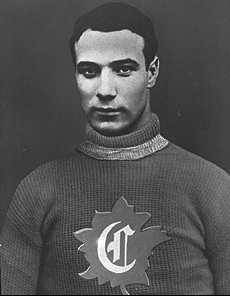
The Canadiens played their first game on January 5, 1910. They won 7–6 in overtime against Cobalt. But this win was later removed from the history books. The CHA league stopped after only two weeks. The NHA decided to restart the season. The Canadiens' first game of the new season was on January 19. They lost 9–4 to the Renfrew Creamery Kings. They won only two of their 12 games that season. They finished last in the league.
After the season, George Kennedy, owner of the Club Athlétique Canadien (CAC), bought the team for $7,500. That same year, the team started wearing its famous red sweater with a blue stripe. In the middle of the stripe was a red C around a red A. The A stood for the CAC.
The Canadiens reached the playoffs for the first time in 1913–14. They tied for the league lead. They played a two-game series for the championship. The winner was decided by total goals. Goalie Georges Vézina shut out the Toronto Blueshirts 2–0 in the first game. But the Canadiens lost 6–0 in the second game. So they lost the series. Two years later, in 1915–16, the Canadiens won the NHA championship. This earned them their first chance at the Stanley Cup. They played the Portland Rosebuds. The series was tied 2-2. The final game was in Montreal on March 30, 1916. Montreal's George Prodgers scored the winning goal with less than four minutes left. This gave the Canadiens their first Stanley Cup!
In 1916, the CAC had money problems. Kennedy separated the hockey team from the CAC. The Canadiens changed their logo to a red "C" with a white "H" inside. The H stands for "hockey." But many people thought it stood for "Habitants," which is why the team is nicknamed "the Habs."
The NHA ended in 1917. This was because of problems between team owners. The Canadiens, Wanderers, Senators, and Quebec Bulldogs created a new league. They called it the National Hockey League (NHL). They did not invite one owner, Eddie Livingstone, to join. Kennedy was a strong leader in the new league. They also needed a fourth team. So, they gave a "temporary" team to the Toronto Arena Company. This team eventually became the Canadiens' rivals, the Toronto Maple Leafs.
Early National Hockey League Years (1917–1932)

Joe Malone scored five goals for the Canadiens in their first NHL game. They won 7–4 against the Senators. He led the league with 44 goals that season. The new league almost stopped on January 2, 1918. A fire destroyed the Montreal Arena, home to both the Wanderers and the Canadiens. The Canadiens moved to the Jubilee Arena. But the Wanderers stopped playing. This left the NHL with only three teams. Montreal won the first half of the season. But they lost the league championship to Toronto.
The Canadiens won the NHL championship in 1918–19. They went to play the Seattle Metropolitans for the Stanley Cup. This series is famous because it was canceled due to a serious illness that affected many players. Defenceman Joe Hall sadly passed away on April 5, 1919.
The Jubilee Rink also burned down that summer. The Canadiens built the Mount Royal Arena as a new home. Team owner Kennedy died in 1921. His widow sold the team to Leo Dandurand, Joseph Cattarinich, and Louis A. Letourneau.
Howie Morenz, a big star, started playing in 1923–24 with Aurel Joliat. The team finished second in the league. But they beat the Senators in the playoffs to win the league championship. They reached the Stanley Cup Finals. Montreal hosted the 1924 Stanley Cup Finals against the Calgary Tigers. The Canadiens won the series in two games. They captured their second Stanley Cup! Morenz was the star, scoring a hat trick in game one.
The Montreal Forum opened in 1924. It was built for a new team, the Montreal Maroons. The Canadiens were invited to play the first game there. The Canadiens played the first game in Forum history on November 29, 1924. They won 7–1 against the Toronto St. Patricks. The Canadiens moved into the Forum in 1926. They shared it with the Maroons until 1938. The Canadiens played their first game against the Boston Bruins on December 8, 1924. This started a long rivalry.
For the 1924–25 season, the Canadiens had a special jersey. They moved their CH logo to their sleeves. They played with a large world globe logo on their chests. Montreal finished third in the league. They beat Toronto in the semi-final. The first-place Hamilton Tigers refused to play in the playoffs unless they got more money. The NHL president suspended the whole team. He declared the Canadiens the league champions. The Habs then played the Victoria Cougars for the Stanley Cup. The Cougars won the series 3–1. This was the last time a non-NHL team won the Stanley Cup.
Georges Vezina collapsed during the first game of the 1925–26 season. He was diagnosed with a serious lung illness. He never played again and passed away in March 1926. In his honor, the team created a new award for the league. It was called the Vezina Trophy. It goes to the goalie who allows the fewest goals. His replacement, George Hainsworth, was the first to win it.
In the 1927–28 season, Morenz was the first player in NHL history to score 50 points in one season. Morenz was also the first NHL player to score a second Stanley Cup winning goal. This happened when the Canadiens beat the Boston Bruins in the 1930 Stanley Cup Finals. The Bruins had a great record, but lost two games in a row to Montreal. The Canadiens became the fourth team to win back-to-back championships. They beat the Chicago Black Hawks in five games to win the 1931 Stanley Cup.
Howie Morenz and Rocket Richard (1932–1946)
Fewer people were coming to games because of the Great Depression. The Habs had a losing record in 1932–33. This led to even smaller crowds. They only had about 2,000 fans per game. The team sold Morenz to the Chicago Black Hawks in 1934 to save money. Fans did not like this move. They gave Morenz a standing ovation when he scored against the Canadiens.
The Canadiens lost $60,000 over two seasons. The team was put up for sale in 1935. The owners tried to sell the team and move it to Cleveland. But a group of Montreal businessmen bought the team. They wanted to keep it in Montreal. The Canadiens struggled on the ice. They finished with the worst record in the league in 1935–36. The new owners asked Cecil Hart to coach the team. They hoped he would make the Habs good again. Hart agreed, but only if the Canadiens brought back Morenz. The team agreed and got Morenz back in a trade.
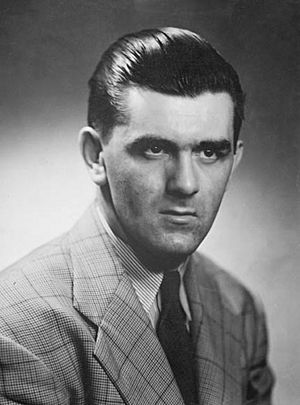
Morenz's return to Montreal was short. In January 1937, he broke his leg badly during a game. He never recovered. He passed away on March 8. Many people believe he died of a broken heart because he couldn't play hockey anymore. On the day of his funeral, 50,000 people visited Morenz's casket at the Montreal Forum. He was called "the Babe Ruth of hockey." A special game in November 1937 raised $20,000 for Morenz's family. Morenz was one of the first players elected to the Hockey Hall of Fame in 1945.
The Canadiens continued to finish near the bottom of the league for several seasons. The worst time was in 1939–40. The coach, Babe Siebert, died before the season began. With an older team, the Canadiens finished last. They won only 10 games. This is still the worst winning percentage in team history. Because the team played so poorly, only about 3,000 fans came to games. The owners thought about stopping the team during World War II. Instead, they sold the team to the Canadian Arena Company.
At this point, help came from an unexpected person: Maple Leafs owner Conn Smythe. The Great Depression had already caused three teams to stop playing. Smythe did not want the Canadiens to stop. He suggested that the Arena Company hire the Maple Leafs' former coach, Dick Irvin. Irvin was a proven winner. The Arena Company agreed. They asked Irvin to help the team become great again.
By 1943, World War II affected many team rosters. But the Canadiens lost only one key player, Ken Reardon. Young star Maurice Richard tried to join the military, but he was turned down due to his health. The Canadiens' general manager reportedly helped his players get jobs in important wartime industries. This helped them avoid military service.
Led by the "Punch Line" of Richard, Toe Blake, and Elmer Lach, the Habs won their fifth Stanley Cup in 1944. They lost only five games in the regular season. In 1944–45, the team won 38 games and lost only eight. Richard was the focus as he tried to be the first player to score 50 goals in a 50-game season. Richard set a record by scoring five goals and three assists in one game. He later broke Joe Malone's goal-scoring record. Opposing teams tried hard to stop him from reaching 50 goals. He was hit and held. Richard finally scored his 50th goal in Boston in the last game of the season. This record, which seemed almost impossible, made Richard a hero in Quebec.
The Original Six Era (1946–1967)
Before the NHL expanded in 1967, the league had only six teams. These teams became known as the "Original Six." Frank J. Selke became the general manager of the Canadiens in 1946. He held the job until 1964. Selke spent several years trying to sign teenage star Jean Béliveau to play for the Canadiens. Beliveau played briefly for the Habs in 1950 and 1952. But he was loyal to his team, the Quebec Aces. He kept turning down the Canadiens. The Canadiens finally bought the entire Quebec senior league in 1953. They made it professional to get Beliveau to join. He signed a five-year contract for $100,000. He played his entire 18-year career with the Habs.
In March 1955, Richard was suspended for the rest of the season, including the playoffs. This happened after he hit a Boston player and then punched a linesman who tried to stop him. The suspension made many people angry at league president Clarence Campbell. He was warned not to attend a game in Montreal. Many French-Canadians accused him of being unfair to them. Campbell ignored the warnings and went to the game on March 17. His presence made fans even angrier. They booed him and threw things. An hour into the game, a fan threw a tear-gas bomb. Fire officials had to clear the building. Fans leaving the Forum met a large crowd of angry protesters. They overwhelmed the police. This event became known as the Richard Riot. It showed the growing cultural differences between French Quebec and English Canada. It is often seen as an early sign of Quebec's Quiet Revolution.
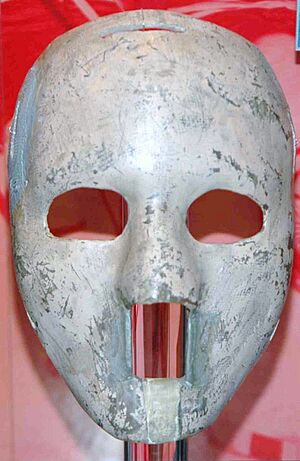
The next day, Richard spoke on a French radio station in Montreal. He asked fans to stop rioting and support the Canadiens in the playoffs. He said he would accept his punishment and return next year to win the Cup. The Canadiens lost in the 1955 Stanley Cup Finals. But Richard led Montreal to the 1956 Stanley Cup, just as he promised.
The 1955–56 season was Toe Blake's first as head coach. He was hired to help control Richard's temper. The 1956 victory started an amazing streak. The Canadiens won five Stanley Cups in a row from 1956 to 1960. The 1960 Stanley Cup Finals was Montreal's tenth straight appearance in the championship series. Richard, the first player to score 500 career goals, retired in 1960. He was elected to the Hockey Hall of Fame in 1961. The usual three-year waiting period was waived because of his great achievements.
Goaltender Jacques Plante had been wearing a mask in practices. But he did not wear it during games. Coach Blake and Selke did not like it. They thought players should not wear face protection. That changed on November 1, 1959. Plante was hit in the face early in a game. Teams did not have backup goalies then. The game was delayed 20 minutes while doctors stitched Plante up. When Blake asked if he was ready to return, Plante refused unless he could wear a mask. Blake was angry, but agreed. He said Plante had to take off the mask when his face healed. Wearing the mask, Plante led the Canadiens on an 18-game unbeaten streak. He finally took off the mask at Blake's request. They promptly lost the next game. Blake gave in. Plante's mask became a permanent part of his gear. He led the Canadiens to their fifth straight Stanley Cup. Other goalies soon followed Plante's lead.
When the NHL started the amateur draft in 1963, the Canadiens could pick two French-Canadian players before any other team. This was called "Cultural Picks." The team used one cultural pick in 1968 and both in 1969. This option was removed after the 1969 draft.
Selke retired in 1964. Sam Pollock took over. Pollock is often called the best general manager in NHL history. He led the Canadiens to nine Stanley Cup championships in 14 years. One of his main strategies was trading older stars for draft picks. This helped the team draft future Hall of Famers like Guy Lafleur, Larry Robinson, and Ken Dryden. The Canadiens won back-to-back titles in 1965 and 1966. They were favored to win the 1967 Stanley Cup Finals against Toronto. The city of Montreal was so sure the Canadiens would win that they built a spot for the Stanley Cup at the Expo 67 site. But the Canadiens lost to the Maple Leafs. This was the last NHL Finals of the Original Six era.
The Expansion Era (1967–1979)
The NHL doubled in size to 12 teams in 1967–68. It was split into two divisions. The East Division had the original six teams. The West Division had the six new teams. The playoff system was set up so an older team would play a new team in the Stanley Cup Finals. The Canadiens bounced back from their 1967 loss. They swept the St. Louis Blues four games to none in both 1968 and 1969. These were their 15th and 16th championships.
The Canadiens missed the playoffs completely in 1969–70. They lost the last playoff spot on a tiebreaker. On the last day of the season, New York beat the Red Wings. This tied them with Montreal in points. New York also had a five-goal lead over the Canadiens in total goals scored. Montreal needed to win their game against the Black Hawks, or score at least five goals, to make the playoffs. They were losing 5–2 with eight minutes left. Coach Claude Ruel pulled his goalie for an extra skater. Montreal gave up five empty-net goals and scored none. They lost the game 10–2. They lost the final playoff spot to the Rangers. This was the only time between 1948 and 1995 that the Canadiens did not make the playoffs.
The team recovered in 1970–71. They won their 17th Stanley Cup. Rookie Ken Dryden had played only six NHL games. But he was named the starting goalie for the playoffs. He led the team to wins over Boston, Minnesota, and Chicago. He won the Conn Smythe Trophy as the most valuable player of the playoffs. Team captain Jean Beliveau retired after the season. He was the fourth player to score 500 career goals. Despite the Cup win, Al MacNeil was removed as coach after one season. This was due to conflicts with players. Scotty Bowman, a Montreal native, replaced MacNeil. Bowman coached the Canadiens for eight seasons. He won five Stanley Cups, including four in a row from 1976 to 1979.
After the success of the Summit Series in 1972, a series of exhibition games between NHL and Soviet teams began. These were called the Super Series. On New Year's Eve 1975, the Canadiens played the Soviet Red Army. This game is considered one of the greatest ever played. It was a match between the two best hockey teams in the world. The game ended in a 3–3 tie. The Soviet goalie, Vladislav Tretiak, made 35 saves.
The 1976–77 Canadiens won 60 games in an 80-game season. They lost only eight times, and only once at home. Guy Lafleur led the league in scoring. He won many awards. Dryden won the Vezina Trophy. Bowman won the Jack Adams Award. Larry Robinson won the James Norris Memorial Trophy. The Canadiens were so dominant that Dryden joked he was "a little bored" because there was no competition. The 1976–77 Canadiens are widely seen as the greatest team in NHL history.
The 1978–79 season ended Montreal's run of four straight championships in an exciting way. They faced the Bruins in game seven of the semi-finals. Montreal was losing 4–3 with less than two minutes left. Boston coach Don Cherry accidentally sent too many players onto the ice. This led to a famous penalty. During the power play, Lafleur scored to tie the game. Yvon Lambert scored in overtime to win the game and the series. The Canadiens then beat the Rangers in five games to win the Cup.
The Canadiens' success in the late 1970s was partly because of the rival World Hockey Association (WHA). The Canadiens were better than other NHL teams at keeping their top players from joining the WHA. The Canadiens played a big part in the 1979 merger with the WHA. This added the Edmonton Oilers, Hartford Whalers, Quebec Nordiques, and Winnipeg Jets to the NHL. After years of talks, a merger agreement was reached. But the NHL owners rejected it by one vote. Most American teams wanted the merger. They thought it would help them challenge Montreal's dominance. But the Canadiens, Vancouver Canucks, and Toronto Maple Leafs were against it. They did not want to split TV money more ways. Fans in Edmonton, Quebec, and Winnipeg started a big protest. They stopped buying products from Molson, who owned the Canadiens. This protest, and pressure from the Canadian government, made Montreal and Vancouver change their minds. The merger passed on March 22, 1979.
Changes and New Success (1980–1996)
The Canadiens went through many changes in the 1980s. Dryden, Lemaire, and captain Yvan Cournoyer retired in 1979. Serge Savard retired in 1981. A trade in 1982–83 sent Rod Langway and Doug Jarvis to the Washington Capitals. New players included Swedish star Mats Näslund and forward Guy Carbonneau. Bob Gainey became the new team captain. Guy Lafleur remained the team's offensive star. He reached 1,000 career points in 1981 in just 720 games. This was the fastest anyone had reached that milestone.
Doug Wickenheiser was the first pick for Montreal in the 1980 NHL draft. This was very controversial. Fans in Montreal wanted the team to pick French-speaking star Denis Savard. Wickenheiser struggled in the NHL. His popularity was hurt by comparisons to Savard's immediate success. He was traded in 1983–84.
Gainey explained the team's changing luck after losing to the Nordiques in 1982. He said, "We can't put on our sweaters anymore and expect to win." The Canadiens' special winning feeling had been broken. They lost to the Minnesota North Stars, the Oilers, and the Nordiques. The loss to Quebec in 1982 was the end of a very intense series. Players tried to hurt and scare their opponents. The media argued about which team better represented French Quebec. Montreal's growing rivalry with Quebec peaked in 1984. They beat the Nordiques in six games. But there was a big fight called the Good Friday Massacre. A hit by Quebec's Dale Hunter on Montreal goalie Steve Penney started a huge brawl at the end of the second period. Another brawl happened before the third period. Ten players were thrown out of the game. Many penalty minutes were given out. This was a turning point. Montreal scored five goals in the third period to win.
Rookie goalie Patrick Roy led the Canadiens to their 23rd Stanley Cup in 1986. They beat the Calgary Flames. This was the first all-Canadian Stanley Cup Finals since 1967. The 1986 Canadiens were young. They were led by rookie coach Jean Perron and forward Claude Lemieux. Roy became the youngest player to win the Conn Smythe Trophy. Brian Skrudland, another rookie, scored the winning goal just nine seconds into overtime in game two of the finals. This was the fastest overtime goal in history. The two teams met again in the 1989 Stanley Cup Finals. This was the most recent all-Canadian Stanley Cup Finals. The Flames won in six games. It was the only time a visiting team beat the Canadiens to win the Cup on Forum ice.
The Stanley Cup celebrated its 100th anniversary in 1993. It returned to Canada with the Canadiens' 24th Stanley Cup victory. This is the most recent NHL championship won by a Canadian team. After losing the first game of their series to the Quebec Nordiques in overtime, the Canadiens won ten overtime games on their way to the title. This set an NHL record for most consecutive overtime wins in a playoff year. Like in 1986, the team was led by Roy. He won his second Conn Smythe Trophy. A key moment of the 1993 Stanley Cup Finals happened in game two. Montreal was losing the series 1–0 and the game 2–1. Coach Jacques Demers asked the referee to check the stick of Los Angeles Kings player Marty McSorley. The referee found the stick was illegal and gave a penalty. Montreal scored on the power play to tie the game. They then won in overtime 3–2. This tied the series. Montreal also won Games 3 and 4 in overtime. They eliminated the Kings in Game 5. The celebration was unfortunately followed by some unrest in the city.
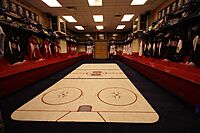
The Canadiens did not repeat their success in 1993–94. The Bruins eliminated them from the playoffs in seven games. Montreal's loss in Game 6 was the last playoff game ever played at the Montreal Forum. The team missed the playoffs completely in 1994–95. This was the first time in 25 years. Montreal made the playoffs in 1995–96. But the team's future changed on December 2, 1995. The Canadiens lost badly, 11–1, to the Red Wings. Patrick Roy allowed nine goals. He was pulled from the game to mocking cheers. Roy was very angry. He felt that coach Mario Tremblay deliberately left him in to be embarrassed. After reaching the bench, he told Canadiens President Ronald Corey, "This is my last game in Montreal."
Four days later, Roy was traded to the Colorado Avalanche. The Avalanche, the former Nordiques, went on to win the 1996 Stanley Cup. Roy won another title with the Avalanche in 2001. He retired in 2003 with more wins than any NHL goalie. The Canadiens then had a long period of not doing well. They missed the playoffs in four of their next ten seasons. They did not get past the second round of the playoffs until 2010. The team's lack of playoff success ended its streak of winning a Stanley Cup in every decade from the 1910s to the 1990s.
The changing costs of sports led the Canadiens to build a new arena in 1996. This was to make more money. The final game at the Forum was on March 11, 1996. They won 4–1 against the Dallas Stars. After the game, a special ceremony was held. Many of the team's greatest members were welcomed onto the ice. Maurice Richard got the loudest cheer. He received a ten-minute standing ovation. Finally, Émile Bouchard, the oldest living former captain, carried a lit torch. It was passed through the Canadiens' history. Bouchard passed it to Richard, who passed it to Jean Beliveau, and so on to each former captain present. It ended with Pierre Turgeon. In 72 years at the Forum, the Canadiens won over 1,500 games and 22 Stanley Cups.
New Home and New Owners (1996–2009)
Five days after the Montreal Forum closed, the Canadiens played their first game at the Molson Centre. It was later renamed the Bell Centre. With seats for 22,500 people, the Bell Centre is said to be the biggest indoor arena in North America. In the first game, Montreal beat the Rangers 4–2. Vincent Damphousse scored the first goal. The Canadiens made the playoffs but struggled in their new arena for the first three seasons. They were eliminated in the first round in 1996 and 1997. In 1998, they won their first playoff series since 1993. But they were swept by the Buffalo Sabres in the second round. This was the last time the Canadiens won a playoff series until 2002.
Montreal finished last in their division in 1998–99. They missed the playoffs. Their 75 points was the lowest in 40 years. There were rumors that the team might be sold and moved. This was due to Quebec's tax system and the low value of the Canadian dollar. The Canadiens denied the report. But the owners, Molson, looked into their future in sports. Montreal missed the playoffs again for the next two seasons. They were losing $10–$12 million each year. Molson wanted to focus on their main business. So, they put the team up for sale in 2001.
No local buyers came forward. A proposed Canadian government help program for the six Canadian teams was canceled. People feared the Canadiens would move to the United States. But American businessman George N. Gillett Jr. bought most of the team and the Molson Centre for $275 million. Molson kept a small share of the team. The NHL also said that any move to a new city would need everyone's approval.
After a bad start in the 2000–01 season, the Canadiens fired coach Alain Vigneault. Michel Therrien took over. The Habs finished last in their division.
Before the 2001–02 season, the team announced that captain Saku Koivu had cancer. He would miss the whole season. Koivu managed to return with three games left in the regular season. He and goalie José Théodore, who won an award that year, led the Canadiens to the playoffs. They upset the Boston Bruins in the first round. Koivu led the team in playoff scoring. He won an award for his dedication and perseverance in returning from cancer treatment. But in the second round, the team lost to the Carolina Hurricanes. The Canadiens missed the playoffs in 2002–03. The team replaced Therrien with Claude Julien.
The first outdoor hockey game in NHL history was the Heritage Classic. It was held on November 22, 2003, in Edmonton. The Canadiens beat the Oilers 4–3. A record crowd of 57,167 fans watched in very cold weather. The success of this game led to the Winter Classic, an annual outdoor game. In the 2004 playoffs, the Canadiens upset the Bruins in seven games. But they lost to the Tampa Bay Lightning in the second round.
The 2004–05 season was canceled due to a lockout. After the Montreal Expos baseball team moved, the Canadiens got their mascot, Youppi. He became the Canadiens' first-ever mascot. After missing the playoffs in 2006–07, the Canadiens won their first division title in 15 years in 2007–08. They also won their first regular season conference title since 1989.
Molson Family Buys Team Again (2009–Present)
The Molson family bought the Canadiens again in 2009. Geoff Molson led the group. The sale price was over $600 million. The team is now owned by the Molson family, not the Molson brewery. The higher price showed that the team was making money again. This was because of a new agreement that controlled player costs. Also, the Canadian dollar was worth more.
On the ice, the team reached the 2010 playoffs as the eighth seed. They upset the top-seeded Washington Capitals. They also upset the defending Stanley Cup champion Pittsburgh Penguins. The Habs lost the Eastern Conference finals to the Philadelphia Flyers.
The NHL brought back the Heritage Classic. The Canadiens played the Calgary Flames in Calgary on February 20, 2011. The Flames beat the Canadiens 4–0. Over 41,000 fans watched.
The Habs finished last in their conference in the 2011–12 season. This was the first time in over 80 years. Many players were injured. After a disappointing season, the Canadiens made changes. They hired Marc Bergevin as the new general manager. On June 5, Michel Therrien was named the new head coach. This was Therrien's second time coaching the Canadiens.
The team improved in the 2012–13 season. They moved from 15th place to second. But they lost 4–1 in the first round against the Ottawa Senators. This was their fourth straight playoff series loss. Defenceman P. K. Subban won an award as the league's best defenseman. The next season, the Canadiens made the playoffs again. They beat the Tampa Bay Lightning in four games. They then faced the Boston Bruins. They beat them in seven games to reach the Eastern Conference Finals. This was their second time since 1993. During game 1 against the New York Rangers, Chris Kreider ran into Carey Price, injuring his leg. Carey Price did not return. The Canadiens lost to the Rangers in six games.
In the 2014–15 season, the team won their third division title since 1992. They beat the Senators in six games in the first round. But they lost in the second round to the Lightning in six games. The season was successful because of goalie Carey Price. He won many awards. He also shared an award for allowing the fewest goals.
The Habs started the 2015–16 season with a nine-game winning streak. But the team struggled later. Many players, including Price, got injured. The Canadiens did not make the playoffs. The team played in the NHL Winter Classic for the first time. They beat the Boston Bruins.
On November 4, 2016, goalie Al Montoya allowed 10 goals in a 10–0 loss. But the Habs later scored 10 goals in a 10–1 win. The team started the 2016–17 season very well. But they struggled later. So, the Habs fired Therrien. Claude Julien replaced him. This was the second time Julien replaced Therrien as coach. On March 30, 2017, the Canadiens made the playoffs. They won their division title a few days later. But they lost their first-round playoff series to the Rangers in six games.
The Canadiens missed the playoffs for the next two seasons. They traded away veteran players. In 2020, the Canadiens were in 12th place when the league stopped due to the COVID-19 pandemic. When the season restarted, Montreal was invited to a playoff tournament. They were seeded 12th. They beat the Pittsburgh Penguins in four games. Jeff Petry scored an overtime goal in Game 1. Price had a shutout in the final game. The team then played the top-seeded Philadelphia Flyers. But they lost in six games.
For the 2020–21 season, the Canadiens played in a special North Division with other Canadian teams. This was due to the health crisis. Coach Julien was fired. Assistant coach Dominique Ducharme replaced him. Montreal took the last playoff spot in the North. They faced their rivals, the Toronto Maple Leafs. This was their first playoff match since 1979. Toronto took a 3–1 series lead. But the Canadiens won three games in a row. The first two were in overtime. Montreal then swept the Winnipeg Jets in four games. Tyler Toffoli scored an overtime goal to win the last game. In the next round, Montreal beat the Vegas Golden Knights. Artturi Lehkonen scored an overtime goal in game six. This sent them to their first Stanley Cup Finals since 1993! The Canadiens were also the first Canadian team to reach the finals since 2011. But they lost in the Finals to the Tampa Bay Lightning in five games.
In 2021–22, the Canadiens did not do as well. They finished last in the league. This was their worst season in team history. They set team records for most losses, most goals allowed, fewest wins, and fewest points. The team started the season poorly. Owner Molson fired the general manager and other staff. He hired Jeff Gorton to lead hockey operations. Gorton then hired Kent Hughes as the new general manager. They plan to modernize the team.
Because they finished last, the Canadiens won the draft lottery. They will pick first overall in the 2022 NHL draft. This is the first time in 42 years.
Retired Numbers

The Canadiens have retired 15 numbers, honoring 18 players. Howie Morenz's number 7 was the first jersey retired. This happened shortly after he passed away in 1937. Maurice Richard's number 9 followed in 1960. His 544 career goals are a team record. Henri Richard, Maurice's brother, was honored in 1975. His number 16 was retired after 21 seasons and 11 Stanley Cups with the Canadiens. Henri holds the record for most games played with the team, 1256.
Jean Beliveau's number 4 was retired in 1971. He left the game as the all-time leading scorer in Stanley Cup playoff history. Beliveau was offered the position of Governor General of Canada in 1994, but he said no. He is the only hockey player known to have been asked to serve in this role. Guy Lafleur's number 10 was retired in February 1985 after he first retired. Lafleur was a six-time All-Star. He won three scoring titles and two most valuable player awards. Also in 1985, Doug Harvey's number 2 was retired. This defenceman won six Norris Trophies as the NHL's top defenceman. Jacques Plante's number 1 was retired on October 17, 1995. Plante changed how goalies played. He leads the Canadiens with 314 career wins.
Leading up to their 100th anniversary, the Canadiens retired more jerseys. They started with three former greats in the 2005–06 season. Montreal first retired number 12 for both Dickie Moore and Yvan Cournoyer. Moore was part of the Canadiens' winning teams from 1956–1960. Cournoyer won ten titles between 1965 and 1979. Bernie Geoffrion was the third player honored. Nicknamed "Boom Boom," Geoffrion was known for inventing the slapshot. He passed away on March 11, 2006, the same day his number 5 was retired.
Serge Savard's number 18 was retired on November 18, 2006. Savard also served as the team's general manager. His defensive partner Larry Robinson's number 19 was retired one year later. Bob Gainey's number 23 was also retired. Gainey was considered one of the best defensive forwards. He won four Selke Trophies and five Stanley Cups. He also coached and managed the team. Patrick Roy's number 33 was retired on November 22, 2008. Roy's jersey retirement brought him "back to the Canadiens family." He had not kept a relationship with the team after his trade in 1995. Emile Bouchard's number 3 and Elmer Lach's number 16 were retired on December 4, 2009. This was part of the team's centennial celebration. They retired Guy Lapointe's number 5 during the 2014–15 season.
Builders Row
The Canadiens created "Builders Row" in 2006. This honors people who worked off the ice and helped the team succeed. Seven people were first included: team founder Ambrose O'Brien; former owners Leo Dandurand, Joseph Cattarinich, Louis A. Letourneau, and Hartland Molson; former team president Donat Raymond; and special advisor William Northey. In 2008, the team added three legendary coaches: Dick Irvin Sr., Toe Blake, and Scotty Bowman. These three coached the Canadiens for a combined 36 years.
Hockey Hall of Famers
The Hockey Hall of Fame was created in 1945. Nine players were first inducted. Two of them were Canadiens: Howie Morenz and Georges Vezina. Morenz was seen as hockey's first superstar. In 1950, he was voted the top hockey player of the half-century. Vezina was known for his "stand up" style of goaltending. He set the standard for future goalies.
Maurice Richard, inducted in 1961, and Jean Beliveau, inducted in 1972, are two of ten players who were inducted without waiting the usual three years. Defenceman Doug Harvey was elected in 1973. Guy Lafleur was one of three players in NHL history to return to playing after being elected. Lafleur had retired in 1984. He was frustrated with the Canadiens' defense-focused system. He returned to the league days after his 1988 election. He played for the New York Rangers and Quebec Nordiques before finally retiring in 1991.
As of 2009, over 50 former Canadiens players have been elected to the Hall of Fame.
See also
- List of Montreal Canadiens seasons
- History of the National Hockey League
- List of Stanley Cup champions


